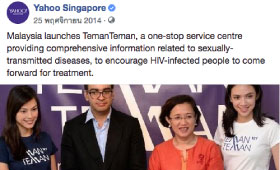|
|
What would you choose: Online or Offline or Mixed services? Feasibility of online HIV counselling and testing among Thai men who have sex with men and transgender women and factors associated with service uptake
What would you choose: Online or Offline or Mixed services? Feasibility of online HIV counselling and testing among Thai men who have sex with men and transgender women and factors associated with service uptake
Nittaya Phanuphak, Tarandeep Anand, Jureeporn Jantarapakde, Chattiya Nitpolprasert, Kanittha Himmad, Thanthip Sungsing, Deondara Trachunthong, Sangusa Phomthong, Petchfa Phoseeta, Sumitr Tongmuang, Pravit Mingkwanrungruang, Dusita Meekrua, Supachai Sukthongsa, Somporn Hongwiangchan, Nutchanin Upanun, Jiranuwat Barisri, Tippawan Pankam, Praphan Phanuphak J Int AIDS Soc. 2018 Jul;21 Suppl 5(Suppl Suppl 5):e25118. doi: 10.1002/jia2.25118. PMID: 30033644 PMCID: PMC6055119 DOI: 10.1002/jia2.25118 Free PMC Article Abstract Introduction: HIV testing coverage remains low among men who have sex with men (MSM) and transgender women (TGW). We studied characteristics of Thai MSM and TGW who chose online and/or offline platforms for HIV counselling and testing and the feasibility of integrating online technologies and HIV self-testing to create service options. Methods: From December 2015 to June 2017, MSM and TGW enrolled from Bangkok Metropolitan Region and Pattaya could choose between: offline HIV counselling and testing (Offline group), online pre-test counselling and offline HIV testing (Mixed group), and online counselling and online, supervised, HIV self-testing (Online group). Sociodemographic data, risk behaviour and social network use characteristics were collected by self-administered questionnaires. Logistic regression models identified covariates for service preferences. Results: Of 472 MSM and 99 TGW enrolled, 202 self-selected the Offline group, 158 preferred the Mixed group, and 211 chose the Online group. The Online group had the highest proportion of first-time testers (47.3% vs. 42.4% vs. 18.1%, p < 0.001) and reported highest HIV prevalence (15.9% vs. 13.0% vs. 3.4%, p = 0.001) as compared to Offline and Mixed groups, respectively. Having tested for HIV twice or more (OR 2.57, 95% CI 1.03 to 6.41, p = 0.04) increased the likelihood to choose online pre-test counselling. Being TGW (OR 6.66, 95% CI 2.91 to 15.25, p < 0.001) and using social media from four to eight hours (OR 2.82, 95% CI 1.48 to 5.37, p = 0.002) or >8 hours (OR 2.33, 95% CI 1.05 to 5.16, p = 0.04) increased selection of online, supervised, HIV self-testing. Providers primarily used smartphones (79.2%) and laptops (37.5%) to deliver online services. Self-testing strip image sharpness and colour quality were rated "good" to "excellent" by all providers. Most participants (95.1%) agreed that online supervision and HIV self-testing guidance offered were satisfactory and well delivered. Conclusions: Online HIV services among MSM and TGW are feasible in Thailand and have the potential to engage high proportions of first-time testers and those with high HIV prevalence. When designing public health interventions, integrating varied levels of online HIV services are vital to engage specific sections of MSM and TGW populations in HIV services. Keywords: HIV testing; Online; counselling; men who have sex with men; transgender women. |

















